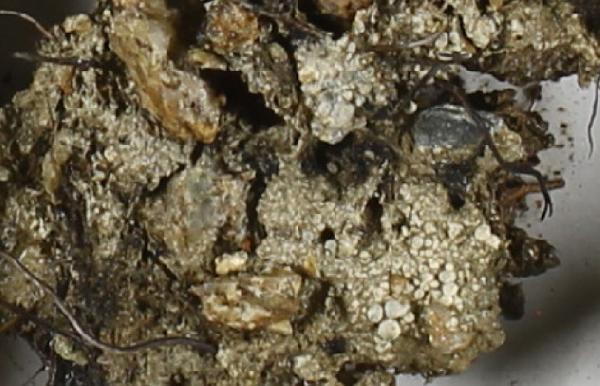Micarea inquinans (Tul.) Coppins
in Rambold & Triebel, Bibl. Lichenol., 48: 169, 1992. Basionym: Abrothallus inquinans Tul. - Ann. Sci. Nat. (Bot.), 17: 117, 1852.
Synonyms: Lecidea inquinans (Tul.) Nyl.; Nesolechia inquinans (Tul.) A. Massal.
Distribution: N - Frl (Tretiach & Hafellner 2000, Brackel 2016), TAA (Hafellner 1994, Brackel 2016).
Description: Thallus totally immersed in the thallus of Dibaeis baeomyces, inapparent, not lichenized. Apothecia micareoid, 0.2-0.4 mm across, black, often arranged in small clusters, with a strongly convex disc, without a proper margin. Proper exciple indistinct; epithecium green (K-, N+ red) or brown (K-, N-); hymenium colourless or pigmented in upper part, 40-65 μm high; paraphyses branched, 1.5-2.5 μm thick at mid-level, the apical cells to 3 μm wide; hypothecium coloured as the epithecium. Asci 8-spored, clavate to cylindrical-clavate, with an unstained wall and a K/I+ blue outer layer and apical dome, the latter with penetrated bya darker tube-like structure, 40-50 x 12-18 µm. Ascospores 1-celled, hyaline, ellipsoid, 8-13 x 4-7 μm. Pycnidia black, immersed in the thallus, the wall red-brown, greenish around the ostiole. Conidia bacilliform, 3.8-5 μm long. Photobiont absent. Spot tests: K-, C-, KC-, P-, UV-. Chemistry: without lichen substances.Note: a non-lichenised parasite on the thallus of Dibaeis baeomyces; reported from the eastern Italian Alps, but largely overlooked, and probably widespread throughout the Alps.
Growth form: Lichenicolous fungus
Substrata: soil, terricolous mosses, and plant debris
Reproductive strategy: mainly sexual
Most common in areas with a humid-warm climate (e.g. most of Tyrrenian Italy)
paras Dibaeis baeomyces
Commonnes-rarity: (info)
Alpine belt: absent
Subalpine belt: rare
Oromediterranean belt: absent
Montane belt: rare
Submediterranean belt: absent
Padanian area: absent
Humid submediterranean belt: absent
Humid mediterranean belt: absent
Dry mediterranean belt: absent

Predictive model

University of Wisconsin - Madison (WIS) – Determiner: Josef Hafellner (1997)
Collector: Josef Hafellner Number: 42476 Date: 1997-07-31 Locality: Austria, Styria, Eisenerzer Alps, Leobner N from forest at Schoberpass, saddle between the peak and der Leobner Wall
49.497222 14.65 Verbatim Coordinates: 49° 29' 50" N 14° 39' E Elevation: 2000 Habitat: patchy "wind" Heide over paleozoic shale (Blaseneckporphyroid) Substrate: on Dibaeis baeomyces on earth - CC BY-NC 3.0 - Source: Consortium of Lichen Herbaria (2023) http//:lichenportal.org/portal/index.php. Accessed on December 15.
Growth form: Lichenicolous fungus
Substrata: soil, terricolous mosses, and plant debris
Reproductive strategy: mainly sexual
Most common in areas with a humid-warm climate (e.g. most of Tyrrenian Italy)
paras Dibaeis baeomyces
Commonnes-rarity: (info)
Alpine belt: absent
Subalpine belt: rare
Oromediterranean belt: absent
Montane belt: rare
Submediterranean belt: absent
Padanian area: absent
Humid submediterranean belt: absent
Humid mediterranean belt: absent
Dry mediterranean belt: absent

Predictive model

 INDEX FUNGORUM
INDEX FUNGORUM
 GBIF
GBIF
 DOLICHENS
DOLICHENS

